Introduction
Amazon is the go-to platform for many new Ecommerce sellers who want to start and scale their business without creating their own platform from scratch.
But did you know that Ebay is widely used to sell not just second-hand products, but brand new items too?
This means Ebay is a potential gold mine for online retailers.
However, this depends on your needs as a seller. In several cases, Amazon will be the best platform, but in others, Ebay has an edge on Amazon.
So how should you figure out which platform is best for you? Instead of trying out both until something sticks, read on to find out the most important differences between selling on Amazon vs Ebay, as well as which Ecommerce platform you should choose based on your current needs as a business owner.
Selling On Amazon Vs. Ebay—What’s The Difference?
Even though Amazon and Ebay are both popular Ecommerce marketplaces, your experience as a seller will vary drastically depending on which one you choose.
Both platforms allow sellers to sell new (and sometimes used) products at a predetermined price, and both platforms give you the option to offer free shipping or have customers pay for shipping instead, but that’s about where the similarities end.
The main differences between both platforms can be found in the following areas:
- The market environment: how competition works
- Your fulfilment options
- The fees you’ll have to pay to sell products
- How many customers you’ll be able to reach
- What the international scene looks like
- The level of trust from consumers on the platform
- The expected quality and price of products
- Let’s break it down for each category.
What Competition You Can Expect
When starting out your Ecommerce business, keep in mind that no matter which marketplace you choose, you’ll have to work hard to get ahead of the competition.
But competition doesn’t work the same way on Ebay compared to Amazon.
New third-party sellers are constantly popping up on Amazon. Right now, there are about 1.9 million sellers on the platform!
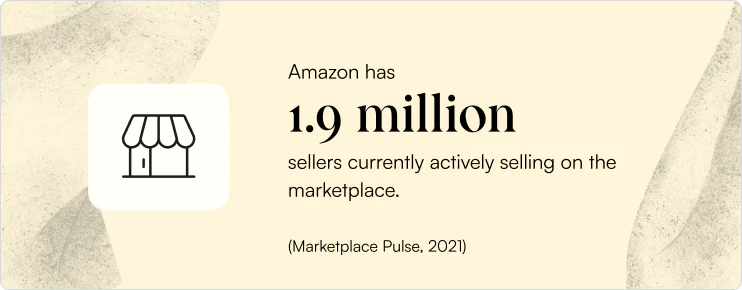
This means you have to compete with these sellers… but that’s not all.
Amazon itself is also a retailer. They sell their own products and partner with larger brands to grow their marketplace. So on top of competing with other sellers like you, you’re also competing against the owner of the platform.
That doesn’t mean you can’t run a successful business, but it is important to keep in mind.
On the other hand, Ebay does not have its own brand of products. This means Ebay as a company isn’t trying to outsell you or other sellers.
Of course, you’re still competing with other sellers and Ebay stores. But if you’re a smaller brand who is just starting out, it can be easier to build brand recognition on that platform and branch out to Amazon later.
HOW FULFILLMENT WORKS
Fulfillment couldn’t be more different when you’re selling on Amazon vs Ebay.
Ebay is a platform where sellers can sell their products. That’s mostly it. As a seller, you’ll need to source, store, package, and ship these items yourself.
If you don’t want to do this on your own, you’ll have to find an outside company who takes care of these aspects of your business for you. You’ll have to work to stitch together your operation so that your customers’ experience is seamless, especially if different people or contractors are in charge of the different parts of the buyer’s journey.
You can take a similar approach on Amazon. However, Amazon has the advantage of offering Fulfilment by Amazon, also known as FBA.
When you let Amazon take care of the fulfillment of your products, all you need to do is take care of the front end of your business—list your products, price them appropriately, reprice them when necessary, market your business, and get reviews.
Amazon takes care of the rest, including:
- Offering free shipping, including two-day, one-day, and same-day shipping for Prime customers
- Storing your items in their warehouses
- Removing your products when necessary
- Packing and shipping out products when you make a sale
- Handling returns
This option is perfect for business owners who are trying to scale their business without the hefty costs of hiring an entire warehouse team. As long as you keep doing your research and upkeep your product listings, your Amazon business can keep scaling.
SELLER FEES
Running a business is never free. But you won’t have to pay the same fees depending on which platform you choose to run your business from.
Amazon’s fees will vary drastically depending on the fulfillment method you choose. It makes sense that storing, packing, and shipping your products yourself would cost less than Amazon FBA.
When you do your own fulfillment (FBS or Fulfillment by Seller), you’ll have to pay a referral fee. This fee depends on your product category. Because you’re shipping your own products, you’ll also need to include those fees when calculating your margins.
Luckily, you can calculate your seller fees without having to do the math yourself or guess what you’ll have to pay using Amazon’s pricing calculator.
For instance, let’s say you’re selling gardening gloves. These gloves cost $9.99 to produce, $2.99 to ship, and are listed at $15.99.
Using the calculator, you can see that you’ll pay a referral fee of $2.85, which puts you at a margin of $3.15 per sale.
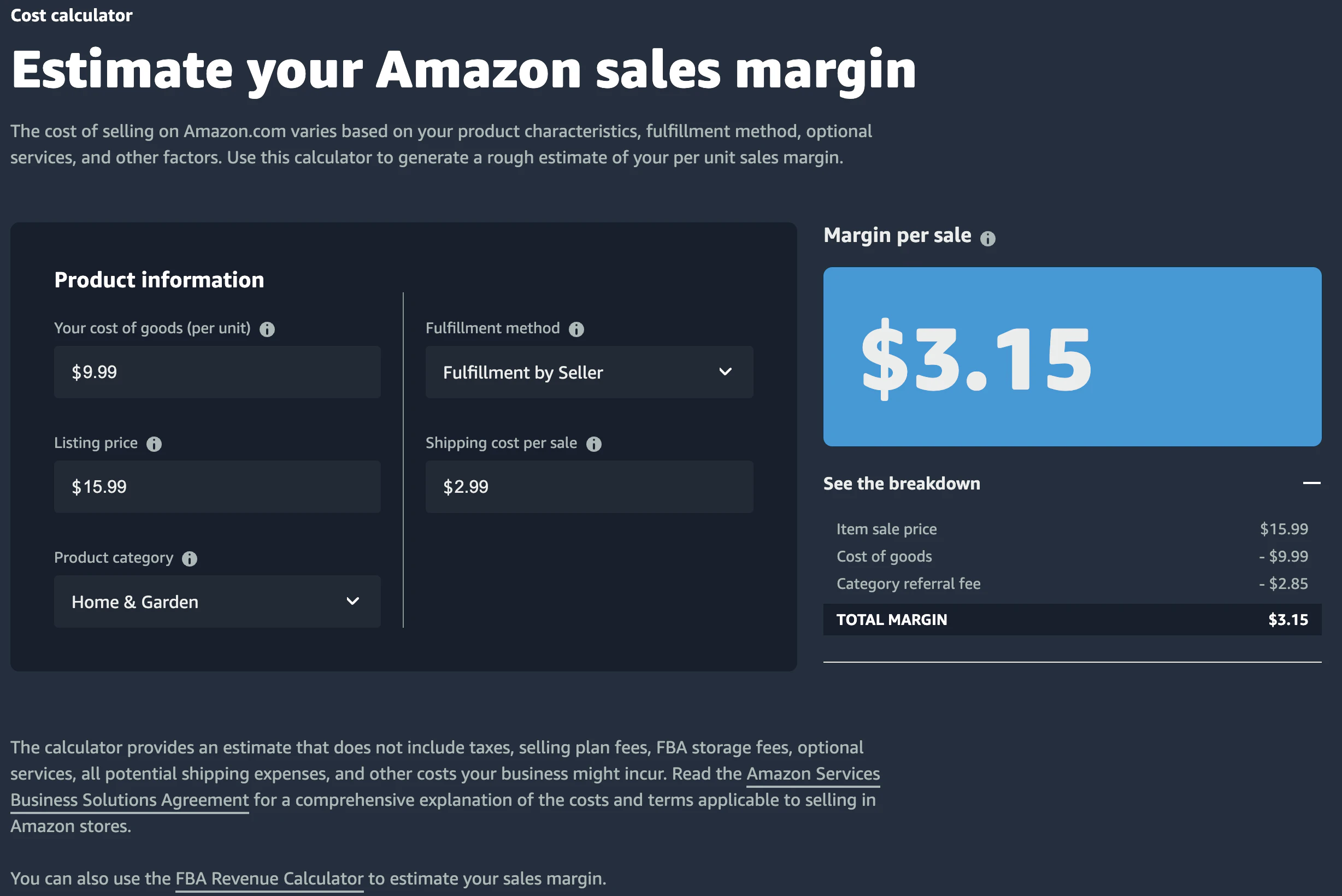
If you were selling the same gardening gloves using Amazon FBA, the pricing structure would be different.
Instead of calculating your shipping fees, you need to enter the weight category of your item. In the case of gloves, you would use the Small standard & 10 oz or less category.
For this product, your FBA fee would be $2.92, and your referral fee would be $2.40, giving you a margin of $0.68 per product sold.

Some categories are more expensive than others, including Books, Fine Art, Gift Cards, and more.
Ebay works a little differently. Because there is no fulfilment program with Ebay, the seller fees will depend on other factors, such as:
- Whether you use Paypal or Ebay Managed Payments to process payments
- Your seller performance
- The type of Ebay store you have (Starter, Basic, Enterprise, etc.)
- Item category
- Whether you’re shipping overseas or not
- Whether you’re using paid ads or not
- Sales tax
- Shipping costs
- Charity donations
You can use this calculator to get an idea of how much you can make from selling your products on Ebay.
Here’s an example of potential numbers you could get:
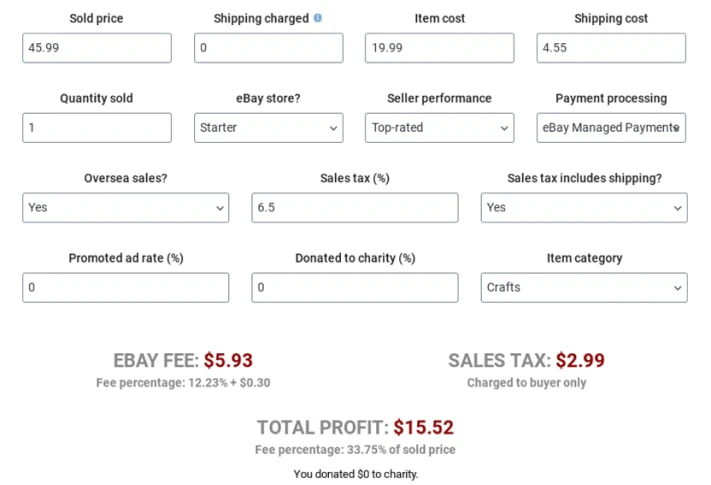
So how does this break down?
Ebay takes several fees from sellers, including:
- Insertion fees: You’ll pay this fee whether or not you sell your item. In short, this is the price it costs to create your listing on Ebay. However, you can get up to 50 free insertions per month.
- Final value fees: Ebay will also take a percentage of the item’s final sale price once the item is sold. Shipping and handling can be included in this fee, and the percentage taken will vary depending on your product category.
- Payment processing fees (if you use eBay Managed Payments instead of Paypal)
- Upgrade fees for your listings: These fees are optional and include extra features for your listing to help you stand out, such as subtitles and bolded fonts.
Separately, you’ll also need to charge sales tax if you’re selling a brand new product.
THE INTERNATIONAL SCENE
Outside of the US, how do Amazon and Ebay compare?
Ebay definitely has more international exposure. In Q4 of 2020, 60% of Ebay sales came from outside the US.
They also have 25 different website domains available across the world.
On the other hand, Amazon only has 12 domains, and the majority of its sales are made in the US. Only 33.21% of its sales came from international orders in Q4 of 2020. So Amazon is definitely more popular with Americans than with the rest of the world, especially when you compare it to Ebay.
That being said, both platforms are still popular worldwide, but they each have their strengths!
CUSTOMER BASE
Both Amazon and Ebay are based in the United States, even though they get a blend of international customers.
But Amazon’s customer base is much larger than Ebay’s. In fact, Amazon is America’s most popular retail website, according to Statista.

Every month, 214.8 million users from across the globe visit Amazon online. Compare this to Ebay, which holds third position with 106.9 million monthly users, right after Walmart.
This means Amazon has more than double the amount of monthly visitors compared to Ebay. In fact, Amazon holds 50% of the US Ecommerce market in 2021!
Here’s another thing to keep in mind—because of Amazon Prime, several Amazon users are paying a premium to access features of the platform, like fast and free shipping options. These customers may be more likely to buy Prime products since they’re already paying for a membership!
CONSUMER TRUST
Both Amazon and Ebay have been around since the mid 1990s, so they have had an online presence almost as long as the Internet has been available to the general public.
Although both companies are well established, they don’t have the same focus on consumer trust.
Amazon is dedicated to earning the trust of its consumers. They understand that it’s less costly to make one customer happy and retain that customer than to cut on costs and lose customers in the process.
For example, customers can return many Amazon purchases for any reason whatsoever, no questions asked. The process is easy and painless, and you don’t even need to go through a customer service rep to initiate a return.
Plus, they pay for return shipping, too!
This comes at a cost to the company, but in return, customers who are able to return items will be more likely to order in the future, since they don’t need to fear getting stuck with a product they don’t like. They know they can afford to take a risk.
73% of customers in the United States consider Amazon a good company for buyers—that’s almost three quarters of available customers in the US! Seeing this stat, it’s pretty obvious that Amazon has earned the trust of its customer base.
You won’t get the same customer-centric experience on Ebay. In order to return an item, customers need to jump through more hoops, and not all items can be returned, either.
Sellers have the option to offer no returns at all. At first, this may seem like a positive aspect of the platform if you’re a seller, but this feature can have a negative impact on consumer trust.
Why? When you allow your customers to return items, you’re telling them that you fully trust in your product. Even the best products get returned sometimes, but when you have a product you trust, you know it has lower chances of getting returned.
On the other hand, seeing ‘no returns’ on a product listing can be a red flag for your potential customers. If there’s something wrong with the product—or if it isn’t at all what was advertised—customers have no way of getting their money back.
The fear of getting scammed is thus much more prevalent when fewer options are available to return items.
As a result, consumer trust isn’t as strong on Ebay as it is on Amazon. Even if you as a seller are trustworthy, you’ll also benefit—or suffer—from the overall consumer trust of the platform you use.
This doesn’t mean Ebay doesn’t offer protection for its buyers! A ‘money back guarantee’ badge is displayed on most listings, but what matters is the long-term consumer trust. And the truth is that Ebay hasn’t caught up to Amazon yet.
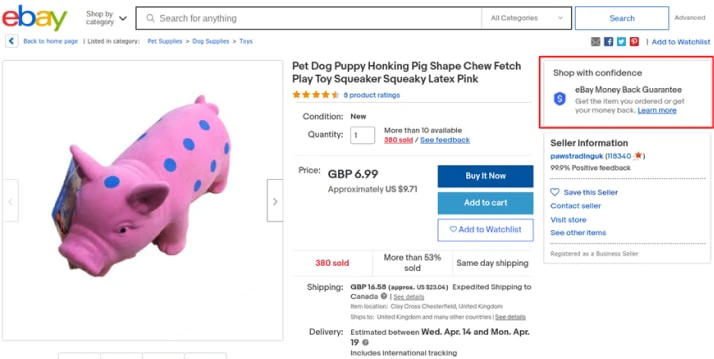
As a customer, it’s much easier to make a purchase without thinking too hard on Amazon, because the platform is trustworthy—even if you’re making this purchase on a seller you don’t know!
QUALITY AND PRICE OF PRODUCTS
Because Amazon is now a leading online retailer, customers expect to mostly find brand new products on there.
The majority of products available are new, but sellers can still offer used products.
Amazon’s prices are what they are—customers can decide to purchase items, used or new, for the listed price, or decide to skip it instead. Of course, listing prices will change over time as sellers adjust their pricing, but there is no auction system.
It’s a different story on Ebay. Although you can sell items on Ebay at a static price (also known as a Buy it Now product), several products are available via auction.
This means you can have a say on your starting price, but the market will decide how high your item’s final price rises. If there is a lot of competition to obtain your item, the price can rise quickly, but if demand is low, you won’t make as much of a profit.
The highest bidder gets the item at the price they offered once the clock runs out.
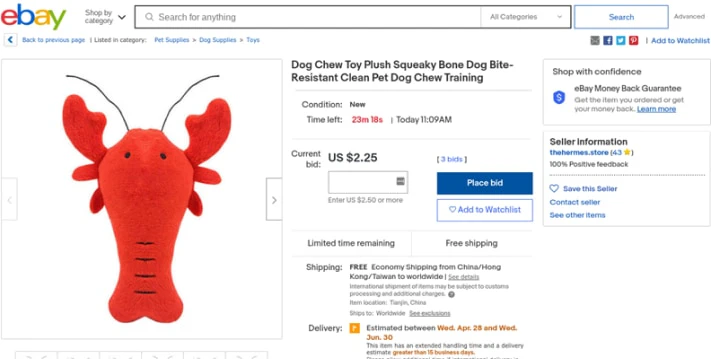
You’ll find new products on Ebay, but it’s also a popular marketplace for selling used items. That’s because Ebay allows sellers to list items in practically any condition, unlike Amazon.
There is one exception for used products: second-hand books. Amazon originally started out as an online bookstore, so it makes sense that it would remain the go-to place to find books of all conditions.
Selling On Amazon Vs. Ebay: How To Choose Which One Is Best For You
Now that you’re aware of all the differences between selling on Amazon vs Ebay, which one should you choose?
It can be difficult to decide which marketplace is best for you when there is so much to consider.
We’ve broken down four situations for each marketplace that determine which one should be the best fit for you.
HERE’S WHEN YOU SHOULD SELL ON AMAZON
If the following apply to you, Amazon will be your best bet to run a successful Ecommerce brand.
You Sell New Products
Yes, you can sell used items on Amazon. But this platform is mostly designed for brand new products, and that’s what customers are looking for.
In fact, there is no filter available for used products when you search for items as a customer!
You can filter for brands, for Amazon Prime products, and other specificities like price and deals, but what you’ll see in the listings are mostly new products. Sometimes you’ll also have used and new items that appear underneath listings, but they’re mostly an afterthought.
Although new products are sold on Ebay, what matters is the customer’s expectations. Because customers use Amazon to search for new products, you’ll have a better chance of selling them on there.
You Want to Sell Primarily to an American Audience
Since Amazon currently holds half of the market share for Ecommerce retail in the United States, it makes sense to sell your products on Amazon if your goal is to target American customers.
This is especially true if you intend to use Amazon FBA! As an Amazon FBA seller, your products will be eligible for Prime Shipping.
126 million US customers have an Amazon Prime membership, which gives you a wide audience of potential customers if this is your target clientele.
You Want to Sell on a Larger Scale
Let’s face it—if you want to grow a multi-million dollar business, but you’re doing everything on your own, Amazon is your best bet—specifically Amazon FBA.
That’s because you’ll be able to scale your business without going through the usual growing pains of scaling an Ecommerce business, like finding larger warehouses, hiring a growing team, employee turnover, and much more.
With Amazon FBA, all those details are taken care of for you, no matter the size of your business. As long as you’re able to supply products to Amazon’s warehouses, you don’t have to worry about creating a bottleneck that will stop your business from scaling.
You Don’t Mind Paying Higher Fees
The aforementioned convenience of Amazon FBA does come with fees. Those fees are much smaller than if you were to hire your own fulfillment team, but when you’re a small brand, those fees can be steep.
However, if you don’t mind paying those fees to invest in growing your business, don’t hesitate to make Amazon the home of your Ecommerce brand.
HERE’S WHEN YOU SHOULD SELL ON EBAY
On the other hand, if the next situations are similar to yours, Ebay could be a better option to run your Ecommerce business.
You’re Mostly Selling Used Items or Collectibles
Are you flipping items you find at garage sales to make a profit? Do you run a baseball card business?
If this is the case, Ebay is the best solution for you. Their platform is designed just like an online garage sale and allows users to search for used items exclusively if they want to.
On Amazon, used items are mostly hidden by new items, so you wouldn’t stand much of a chance against your competitors if your business mostly relies on used items.
You’ll be especially successful on Ebay if the demand for your products is high, since the auction system will ensure the price of your items goes up!
You Want to Save on Fees
Want to fatten up your margins? Ebay offers fees that aren’t quite as steep as the ones you’ll find on Amazon.
If you prefer to cut back on fees, Ebay is the way to go.
You Want to Target an International Audience
Because only a third of Amazon buyers come from outside the USA, it isn’t the best Ecommerce platform for business owners who want to expand to an international audience.
On the other hand, two thirds of Ebay’s audience is outside the USA. Ebay doesn’t have as much of the market share in the US, but it can definitely help you reach a wider audience across the world if this is your goal.
You Want to Handle Inventory and Fulfillment Yourself
One of the biggest advantages of using Amazon as a selling platform is Amazon FBA.
But if you plan on managing your own inventory and taking care of fulfillment for your customers, Amazon FBA won’t be of much use to you.
If you would rather take care of that aspect of your business—whether you do everything yourself or want to be in charge of hiring your own team—you can start a store on Ebay and benefit from the fact that you’re not competing against the platform’s own brand to sell your products.
Desired Outcome
There is no one ideal Ecommerce platform—it all depends on your current situation and your Ecommerce goals.
The perfect platform for you should allow you to:
- Target the right audience
- Establish a pricing strategy that makes sense for your niche of products
- Manage inventory and fulfillment depending on your needs
- Work with wide enough profit margins to make a profit from your business
- Scale to the level you imagine your business to be
Before you choose whether Amazon or Ebay is the best Ecommerce platform for you, make sure to establish your business model and goals. Only once you have an idea of your short-term and long-term goals will you be able to choose the appropriate marketplace for you.
Selling on Amazon vs. Ebay: Build a Scalable Ecommerce Business
That’s it—by now you should have a solid idea of which platform you should choose based on the type of products you have, the business model you want to build, and how involved you want to be in the fulfillment of your orders.
Not sure what it takes to handle your inventory for an Ecommerce business? Check out this post, where we go in-depth about managing your inventory on Amazon!













.webp)

.webp)








.webp)










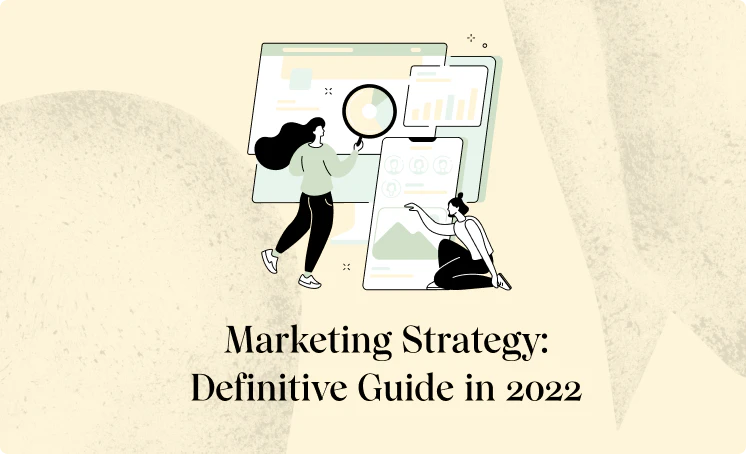






























.webp)






